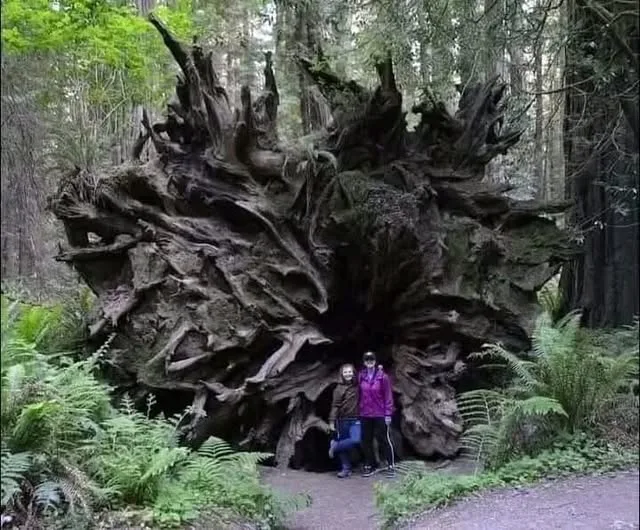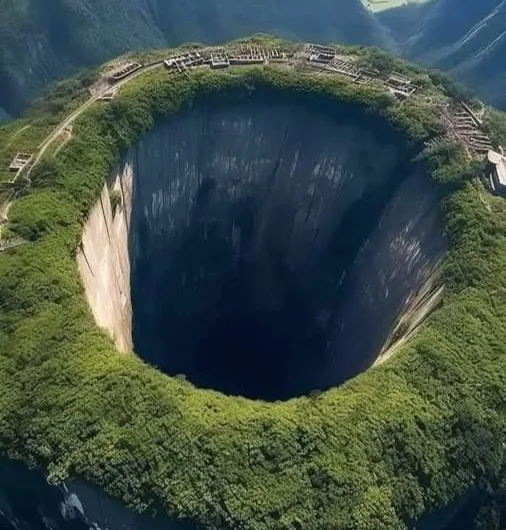
The Dyerville Giant: A Fallen Titan of Humboldt Redwoods
The Dyerville Giant, a colossal coast redwood (Sequoia sempervirens), stood as one of the world’s tallest trees until its dramatic fall in March 1991 in Humboldt Redwoods State Park, California. Measuring 362 feet tall—taller than the Statue of Liberty (305 feet including pedestal)—with a 17-foot diameter and 57-foot circumference, this ancient giant was a marvel of nature. Estimated to be 1,600–2,000 years old, its collapse shook the earth, registered on a seismograph, and echoed like a train crash. Today, visitors can walk its length in the park, marveling at its massive trunk and intricate root system, a poignant reminder of the power and fragility of these living monuments.

The Dyerville Giant: A Towering Legend
Located along the Founder’s Grove Loop Trail in Humboldt Redwoods State Park, the Dyerville Giant was a celebrated icon among redwoods, often cited as the world’s tallest tree in the late 20th century, though exact rankings varied due to measurement challenges. Its vital statistics were staggering:
Height: 362 feet (110.3 meters), equivalent to a 36-story building.
Diameter: 17 feet (5.2 meters) at breast height (4.5 feet above ground).
Circumference: 57 feet (17.4 meters) at the base, requiring multiple people to encircle it.
Volume: Estimated at 36,000 cubic feet, with a weight of several million pounds.
Age: Likely 1,600–2,000 years old, having sprouted during the Roman Empire or earlier, surviving fires, floods, and human encroachment.
The tree’s name derives from the nearby ghost town of Dyerville, a former logging hub along the Eel River, abandoned by the 1930s. Its towering presence drew visitors, scientists, and conservationists, symbolizing the resilience of coast redwoods, which thrive in California’s foggy coastal belt due to their ability to absorb moisture through needles and roots.
The Fall: A Seismic Event
On March 24, 1991, after a winter of heavy rain and strong winds, the Dyerville Giant succumbed to natural forces and fell during a storm. Several factors contributed:
Saturated Soil: Weeks of rain softened the soil, weakening the tree’s shallow but extensive root system (spanning up to 100 feet but only 6–12 feet deep).
Wind: Gusts, common in the region, applied immense pressure to the tree’s canopy, which acted like a sail.
Neighboring Tree Impact: Some accounts suggest a smaller tree fell into the Dyerville Giant, destabilizing it, though park records emphasize wind and soil conditions as primary causes.
The collapse was monumental:
Seismic Impact: The impact registered on a seismograph at Humboldt State University, 10 miles away, equivalent to a minor earthquake (magnitude estimated at ~2.0–2.5). The ground vibrated as the tree’s mass struck the earth.
Sound: Witnesses described the crash as a “deafening roar,” likened to a train derailment or artillery fire, audible over a mile away. A camper in the park, quoted in a 1991 San Francisco Chronicle article, said, “It was like the forest screamed.”
Damage: The fall shattered the upper trunk into fragments, scattered debris across 100 yards, and left a 10-foot-deep crater where the roots upended. Nearby trees were scarred but survived.
The event stunned park rangers and visitors, with one ranger noting, “It felt like losing a family member” (Times-Standard, 1991). The tree’s fall highlighted the vulnerability of even the mightiest redwoods to natural cycles.
The Giant Today: A Walkable Monument
Since 1991, the Dyerville Giant has remained in place, untouched by salvage efforts to preserve its ecological role and educational value. Visitors to Humboldt Redwoods State Park can experience it along the Founder’s Grove Loop Trail (0.6 miles, ADA-accessible):
Length and Scale: Walkers can traverse the entire 362-foot length, from the sprawling root ball (up to 30 feet high, exposing a tangled network) to the splintered crown. The trunk’s diameter dwarfs human scale, with some sections requiring a ladder to climb over.
Root Structure: The exposed roots, once anchoring the giant, reveal how redwoods interlock with neighbors for stability, a trait called root grafting. The root ball’s size—larger than a house—amazes visitors.
Decay and Renewal: The fallen tree supports a mini-ecosystem, hosting mosses, ferns, fungi, and small animals like salamanders. New redwood sprouts, called burl shoots, emerge from the trunk, demonstrating the species’ regenerative ability.
Interpretive signs along the trail detail the tree’s history, with benches inviting reflection. X posts capture the awe: “Walking the Dyerville Giant feels like stepping into a Jurassic forest,” one user wrote in 2024. Another said, “The roots alone are a sculpture—nature’s masterpiece.”
Ecological and Cultural Significance
The Dyerville Giant’s story underscores the unique biology of coast redwoods and their cultural resonance:
Redwood Ecology: Redwoods, the tallest trees on Earth (up to 380 feet in living specimens like Hyperion, discovered 2006), thrive in a narrow 450-mile coastal strip from Big Sur to southern Oregon. Their longevity (up to 2,500 years) and fire-resistant bark make them ecological anchors, storing 2,500 metric tons of carbon per hectare, more than any other forest type (Nature, 2019).
Conservation: The fall coincided with heightened conservation efforts. Save the Redwoods League, founded 1918, purchased much of Humboldt Redwoods State Park (53,000 acres), protecting giants like the Dyerville. Logging reduced 96% of old-growth redwoods by the 1990s, making survivors critical for biodiversity.
Cultural Impact: Native tribes like the Sinkyone and Yurok revere redwoods as sacred, using them for canoes and ceremonies. The Dyerville Giant’s fall inspired art, documentaries, and renewed advocacy, with its story featured in PBS’s The Trees (1992).
Visiting the Dyerville Giant
Humboldt Redwoods State Park, 250 miles north of San Francisco along Avenue of the Giants, is accessible year-round:
Getting There: Drive via US-101 to the Founder’s Grove exit, 4 miles north of Weott. Parking is free; no entrance fee for the park.
Trail: The Founder’s Grove Loop (30–45 minutes, flat) passes the Dyerville Giant and other giants like the Founder’s Tree (346 feet, still standing). Open dawn to dusk.
Tips:
Visit in spring (April–June) for lush greenery or fall (September–November) for fewer crowds and mild weather (50–70°F). Winter storms may close trails.
Wear sturdy shoes; the trail can be muddy. Bring water and binoculars for wildlife (e.g., banana slugs, deer).
Respect the site: no climbing or carving on the tree to preserve it.
Nearby: Explore Rockefeller Forest (home to the tallest tree cluster) or Eel River swimming holes. The Visitor Center (Weott) offers maps and exhibits ($5 suggested donation).
Clarifications and Context
Height Ranking: In 1991, the Dyerville Giant was among the tallest known trees, but measurements were imprecise. Stratosphere Giant (370 feet, discovered 2000) and Hyperion (380.3 feet, 2006) later surpassed it. Pre-1991 claims of “world’s tallest” were based on surveys by National Geographic (1960s–1980s).
Seismograph: The seismograph record is verified by Humboldt State University archives, though the exact magnitude is debated (2.0–2.5 is an estimate based on local reports).
Age: The 1,600–2,000-year estimate comes from ring counts of similar fallen redwoods, as the Dyerville’s base is too decayed for precise dating. Some sources cite 1,500 years, but 1,600+ is more likely given its size.
Why the Dyerville Giant Matters
The Dyerville Giant’s fall was a humbling reminder of nature’s cycles—growth, endurance, and inevitable decline. Its 362-foot stature, 2,000-year lifespan, and seismic collapse embody the awe-inspiring scale of redwoods, while its preserved remains invite reflection on conservation and impermanence. For visitors, walking its length is a tactile encounter with deep time, connecting them to an era when Rome rose and fell. For scientists, it’s a case study in forest ecology and carbon storage. As one X user put it, “The Dyerville Giant isn’t just a tree—it’s a time machine.”
Humboldt Redwoods State Park, protecting 23% of remaining old-growth redwoods, ensures the Giant’s legacy endures, inspiring advocacy amid threats like climate change (droughts stress redwoods) and development. The Dyerville Giant, though fallen, stands tall in our collective imagination—a titan whose echo still shakes the earth.


